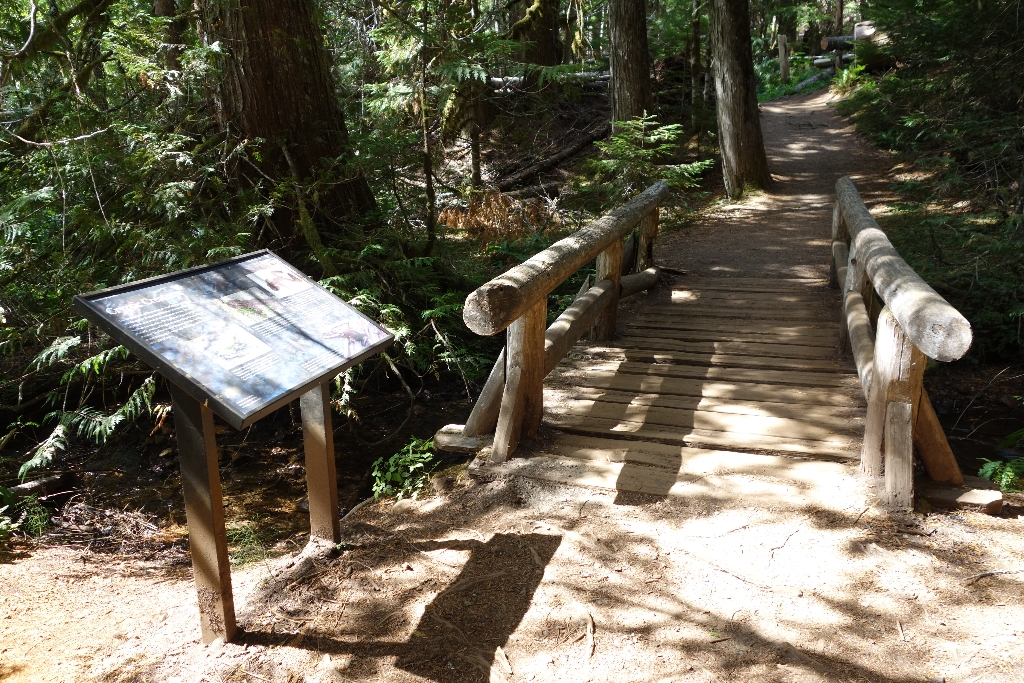
Title: Cryptic Creatures
Main Text
The damp meadow and forest floor are ideal habitats for frogs and salamanders. Because their skin must stay moist, these amphibians need water or wet surfaces to survive. They also need water to reproduce. The Pacific tree frog breeds in wetlands, ponds, and temporary pools, where there are fewer predators. The Coastal tailed frog breeds in fast-flowing streams, laying eggs in long, bead-like strings attached to undersides of rocks.
Secondary Text
Pacific tree frogs (Pseudacris regilla), also known as chorus frogs, are masked, two-inch-long frogs that change color to blend into their environment. “Ribbit”, “robbit”, “rabbit” are the loud synchronized, competing calls of the males. A loud “kreck-eck” is an advertisement call.
The Pacific giant salamander (Dicamptodon tenebrosus) is another amphibian that only lives in the Pacific Northwest. This salamander might metamorphose (change) into a terrestrial adult, living primarily on land and returning to the stream to breed. Others retain their youthful aquatic adaptions and live only in water.
Nowhere else in the world can boast of having Coastal tailed frogs (Ascaphus truei). They are only found in the Pacific Northwest. Living cryptic lives in this rocky stream, these frogs are seldom seen and never heard. Adapting to noisy streams, tailed frogs lack a vocal sac for calling and do not have external ears or a middle ear bone for hearing. Because they live in fast moving water, the male, unlike any other frog, has a tail for internal fertilization. Hardened fingertips assist with crawling along the rocky bottom. Small lungs decrease buoyancy, so the tailed frogs breathe mostly through their skin.
Red-legged frogs (Rana aurora) occupy meadow ponds during breeding season and then move to a moist forest habitat. The red-legged frog is twice the size of the vociferous chorus frog but it is seldom heard. Their quiet, grunt-like call is often made underwater.
Listen for the chorus frog, especially in evenings, spring to fall.
Exhibit Panel Description
A photo of rushing water in a creek, the out-of-focus ripples creating an abstract pattern, fills the exhibit panel. The main text is in the upper left corner. Three photos form a diagonal row, with the first photo under the main text, the second photo placed to the right and slightly higher in the middle of the panel, and the third photo in the upper right corner. In the lower right corner is a cutout photo of a large frog with reddish skin and black spots sitting on a wet log. Under each of the photos is a paragraph of secondary text relating to the photo. The first photo, the Pacific tree frog, is of a small, bright green frog sitting on a rock. The second photo of the Pacific giant salamander shows a large salamander with glistening brown skin covered in wavy darker brown stripes. The third photo of a coastal tailed frog shows a small reddish-brown frog with a short, pointed tail. Next to the cutout of the frog in the lower left corner of the panel is the text for red-legged frogs. The final line of secondary text is set into a small grey oval in the bottom left corner of the panel. Above the text is a small graphic of a historic gas lantern lit with a soft yellow light.
Visit This Exhibit Panel
This exhibit panel is located in Longmire along the Trail of the Shadows, a short trail that starts across the street from the National Park Inn. Longmire is open year-round.
Is there something we missed for this itinerary?
Itineraries across USA


















































